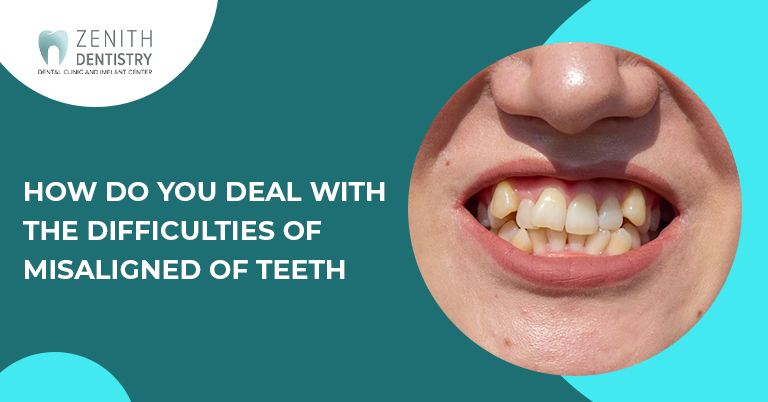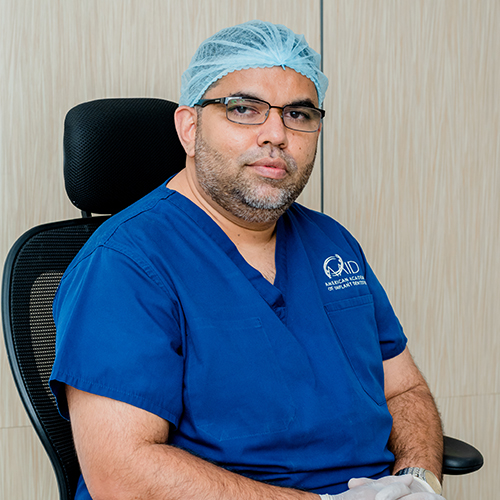
How do you deal with the difficulties of Misaligned teeth?
Dental Misalignment is a physical and functional mouth defect that is more widespread than you might think. Very often, Misaligned, especially if minor, is not recognized as a particularly serious problem by those affected by it. Still, under a careful look, like that of the dentist, it is immediately recognizable. On the contrary, if the Misaligned teeth is serious and evident, it is more frequent to consult a dentist or orthodontist in the hope of correcting the defect.
What is Dental Misalignment?
A Dental Misalignment is an abnormality in the relationship between the upper and lower dental arch. A normal occlusion is characterized by good positioning of the upper teeth in relation to the lower teeth. The teeth must fit together well to ensure maximum chewing efficiency. For example, occlusion is not normal when:
- The upper teeth are overdeveloped
- The teeth are separated from each other by too large spaces
- The teeth deviate from their direction or overlap each other
Severe Misalignment can lead to phonetic, joint, or chewing problems. Misaligned teeth can also wear prematurely and encourage plaque buildup when they are difficult to clean. Finally, Dental Misalignment has aesthetic consequences; certain malpositions can be considered unsightly.
What are the causes of Dental Misalignment?
Several factors can contribute to Dental Misalignment:
- Tooth loss: a lost tooth not replaced by a bridge or implant tends to cause Dental Misalignment. Adjacent teeth end up occupying the empty space by moving.
- Congenital jaw malformations: when the size of a jaw is too small compared to that of the teeth, this results in dental crowding.
- The habit of pushing the tongue forward and/or sucking the thumb: These oral habits usually cause the teeth in the upper jaw to move forward.
- Bruxism: This unconscious frictional movement of the teeth during sleep can lead to premature wear of the teeth and cause an imbalance in the jaws.
What are the possible consequences of Dental Misalignment?
The consequences of Dental Misalignment, therefore of a misalignment between the teeth of the upper and lower arch, are multiple and concern both the aesthetic and functional spheres.
The presence of a Misaligned, especially if associated with dental crowding, can primarily lead to consequences for the aesthetics of the smile, which will immediately appear unharmonious, but above all, for the health of the teeth.
Malocclusion, in fact, often leads to problems of gingival inflammation, tooth decay, and other problems due to an incorrect position of the arches in relation to each other.
Malocclusion can then bring out or worsen another very common disorder, bruxism: those who do not have impeccable dental occlusion and experience dental overcrowding and Misaligned teeth will tend, involuntarily, especially during sleep, to clench their teeth together with consequences on the enamel and the health of all teeth.
The consequences of an occlusion must, therefore, be contained promptly through a thorough dental examination, which will allow the dentist to evaluate the extent of the occlusion defect, evaluating the best treatment to implement on a case-by-case basis.
In particular, when it comes to dental occlusion, the closed bite, also called covered or closed, is perhaps one of the most widespread situations and also one that is often underestimated and considered simply an aesthetic imperfection.
The consequences of a closed bite, as well as those of Dental Misalignment, embrace a whole series of disorders ranging from chewing defects to muscle and back pain, up to even phonetic and pronunciation problems.
The unnatural movement of the jaw backward compared to its natural position then forces the neck and shoulder area to undergo continuous tension, which affects the body, resulting in tension headaches and a stiff neck.
Only the dentist will naturally be able to evaluate the extent of the incorrect dental occlusion, but among the most used solutions, there is undoubtedly the use of fixed braces and, when the case allows it, transparent orthodontics.
Do-it-yourself is always not recommended; perhaps using a soft bite, which, in addition to containing any symptoms related to nocturnal bruxism, cannot improve an advanced level of incorrect occlusion.
What are the different types of Dental Misalignment, and how to correct them?
A dentist will categorize a Misaligned teeth according to how the top and lower first molars fit together. Three basic categories are:
- Class 1 Misaligned: The upper molars overlap the lower molars correctly, but the other teeth are too spaced or too close together
- Class 2 Misaligned: The upper teeth are placed further forward than the lower teeth
- Class 3 Misaligned: The lower teeth are placed further forward than the upper teeth
To clarify the diagnosis, the practitioner can use an X-ray giving an overview of the configuration of the jaw and the alignment of the teeth. An MRI (Magnetic Resonance Imaging) is also useful for detecting meniscus abnormalities, which ensures jaw mobility. Once the diagnosis has been established, your dentist can direct you toward the treatment most suited to your type of Dental Misalignment:
- Fixed orthodontic device placement
- Wearing a removable splint
- Selective grinding, which consists of cutting certain parts of the teeth
- Orthognathic surgery, which allows the upper jaw and the lower jaw to be correctly repositioned
Malocclusions: is it necessary to correct them all?
It is not necessary to correct all Misaligned. In fact, some people are not bothered on a daily basis by their dental malpositions. Treatment should nevertheless be considered when the Misalignment leads to:
- A loss of self-confidence due to a misaligned smile or facial asymmetry
- Premature wear of teeth
- Chewing and swallowing problems ( jaw locking or cracking)
- Speech problems ( speech delays and disturbances)
- Temporomandibular joint (TMJ) disorders
- Oral hygiene problems, with brushing being more difficult due to overlapping teeth or lack of space between teeth
Do you suffer from one or more symptoms linked to Dental Misalignment? A dentist can offer you solutions adapted to your situation.
Final Words
In conclusion, Dental Misalignment is a common condition that can have both aesthetic and functional consequences. It may result from various factors, including tooth loss, congenital jaw abnormalities, oral habits, and bruxism. Identifying and addressing Misalignment is essential to prevent issues like premature tooth wear, gingival problems, and bruxism-related complications. Treatment options range from orthodontic interventions to selective grinding and orthognathic surgery, tailored to the specific type and severity of Misaligned. Seeking professional advice is crucial, especially if Misaligned teeth leads to confidence, speech, or chewing difficulties. Your dentist can provide personalized solutions for your situation.






